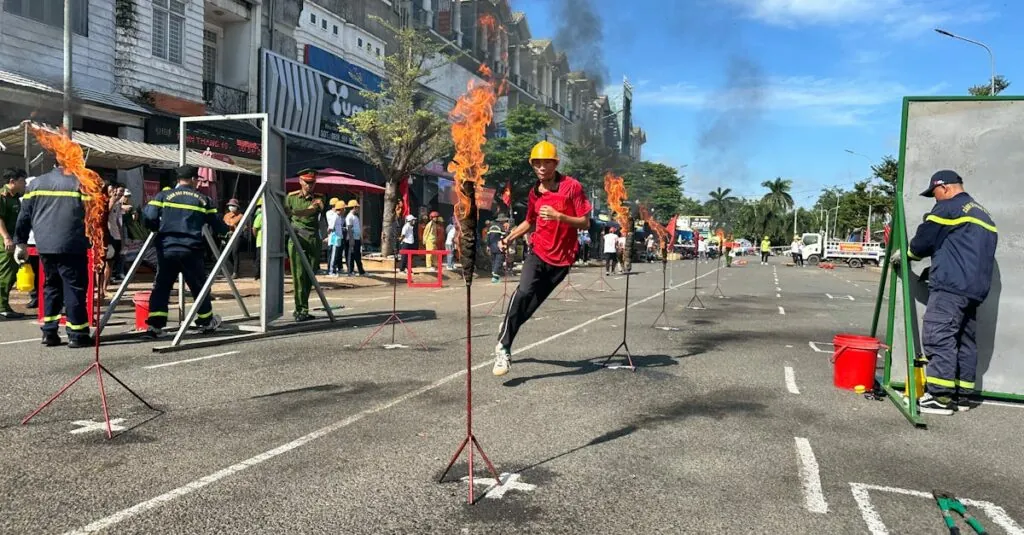Table of Contents
ToggleWhen it comes to battling flames and saving lives, firefighters need more than just a trusty hose and a shiny helmet. They need to be in peak physical condition. Firefighter fitness training isn’t just about lifting weights; it’s about building strength, endurance, and agility to tackle the unexpected. After all, nobody wants to be the one who runs out of breath while trying to rescue a cat from a tree.
Imagine racing into a burning building with the agility of a ninja and the strength of a superhero. With the right training, firefighters can achieve that and more. This isn’t just about looking good in those turn-out gear selfies; it’s about being ready for anything the job throws their way. So, let’s dive into the world of firefighter fitness training and discover how it transforms brave men and women into the ultimate life-saving machines.
Overview of Firefighter Fitness Training
Firefighter fitness training encompasses various components crucial for optimal performance in emergency situations. Emphasis on strength, endurance, and agility enables firefighters to tackle demanding tasks, such as lifting heavy equipment and rescuing individuals from perilous environments. Each training program must focus on specific skills necessary for the profession.
Cardiovascular fitness ranks at the forefront of firefighter training. Activities like running, cycling, and swimming enhance endurance, enabling quick responses in high-stress situations. Moreover, these exercises improve recovery times during intense physical exertion.
Strength training plays a vital role in developing muscle power. Training routines often incorporate bodyweight exercises, free weights, and resistance bands. These methods enhance overall strength, particularly in core areas that stabilize the body while performing critical tasks.
Agility drills also contribute significantly to firefighter effectiveness. Incorporating ladder drills, cone exercises, and shuttle runs cultivates quickness and coordination. High agility levels support firefighters in navigating complex environments, where swift movements can mean the difference between safety and danger.
Functional training mirrors real-life scenarios encountered on the job. Firefighters often engage in exercises that mimic lifting, carrying, and climbing, which prepares them for the physical demands of the profession. By focusing on functional movements, they improve their ability to perform tasks safely and efficiently.
Mental resilience complements physical conditioning. Firefighters face high-pressure situations requiring mental clarity and emotional stability. Incorporating mindfulness and stress management techniques into training keeps them prepared for the psychological challenges of their roles.
Ultimately, a comprehensive firefighter fitness program integrates these elements, ensuring that first responders are fit to perform their life-saving duties effectively.
Importance of Fitness for Firefighters
Fitness plays a crucial role in the effectiveness of firefighters. Being physically fit enables them to meet the intense demands of their job.
Physical Demands of Firefighting
Firefighting requires immense physical strength and endurance. High temperatures and heavy gear can lead to fatigue, which emphasizes the need for cardiovascular fitness. Quick decision-making is essential, especially during emergencies involving rescues. Strength training creates muscle power, allowing firefighters to lift and carry individuals safely. Agility enhances their ability to navigate obstacles in a burning building. Regular training prepares them to handle various physical challenges effectively.
Long-Term Health Benefits
Staying fit provides firefighters with numerous long-term health benefits. Cardiovascular health improves significantly through consistent training, reducing the risk of heart disease. Muscular strength maintains bone density, which can prevent injuries. An active lifestyle contributes to mental resilience, helping firefighters manage stress more effectively. Regular physical activity supports optimal weight management, lowering the risk for obesity-related conditions. Overall, fitness not only fosters job performance but also enhances overall well-being throughout their careers.
Components of an Effective Fitness Program
Firefighter fitness training comprises several key components that enhance overall performance and safety during emergency situations.
Strength Training
Strength training forms the foundation for physical capability in firefighting. It includes bodyweight exercises and resistance training. These essentials build muscle power, enabling quick lifting and carrying of heavy equipment. For example, squats, lunges, and deadlifts improve lower body strength vital for climbing stairs and navigating obstacles. Incorporating functional movements mimics real-life scenarios. Effective programs often include high-rep circuits to enhance muscular endurance, crucial for prolonged tasks. Overall, a well-rounded strength regimen ensures firefighters can execute their duties without risking injury.
Cardiovascular Endurance
Cardiovascular endurance plays a vital role in firefighting performance. This component enhances stamina necessary for high-intensity situations and allows quicker recovery from exertion. Engaging in activities like running, swimming, or cycling builds a solid aerobic base. Additionally, interval training effectively increases heart rate and mimics the unpredictable nature of firefighting events. Regular cardiovascular workouts condition the body to handle extended periods of physical activity while wearing heavy gear. A strong cardiovascular system also aids in preventing fatigue during challenging calls.
Flexibility and Mobility
Flexibility and mobility are critical to a firefighter’s fitness program. These components allow for a full range of motion in joints and muscles. Incorporating dynamic stretching before workouts and static stretching afterward helps maintain flexibility. Engaging in yoga or Pilates strengthens core stability while promoting balance. Additionally, improving mobility through targeted exercises enhances overall physical performance. This aspect reduces the risk of injuries during strenuous tasks and supports recovery after shifts. Prioritizing flexibility ensures that firefighters can maneuver safely in tight spaces or while carrying heavy equipment.
Common Training Protocols
Firefighters utilize various training protocols that enhance their physical capabilities. These methods focus on strength, endurance, and functional movement to prepare them for demanding situations.
Functional Training Techniques
Functional training techniques simulate real-life firefighting scenarios. Exercises such as tire flips and ladder climbs develop strength and coordination. Using tools like kettlebells and medicine balls helps improve grip strength, a critical factor during emergency responses. Additionally, engaging in team-based drills fosters communication and teamwork, vital for efficient operations. Movements in functional training mirror those required for lifting and carrying equipment, optimizing performance on the job.
High-Intensity Interval Training (HIIT)
High-Intensity Interval Training (HIIT) significantly boosts cardiovascular fitness. It involves short bursts of intense effort followed by brief recovery periods. This method mirrors the unpredictable nature of firefighting, where quick bursts of energy are essential. Participants might alternate between sprinting and jogging, maximizing endurance and speed. Studies show that HIIT can improve aerobic capacity more effectively than traditional steady-state exercises. Moreover, its time-efficient approach allows firefighters to fit workouts into busy schedules, ensuring they maintain peak performance levels.
Tips for Staying Motivated
Staying motivated in firefighter fitness training requires a clear focus and support.
Setting Realistic Goals
Setting achievable goals helps maintain motivation. Break larger fitness objectives into smaller, manageable milestones. For instance, a firefighter may aim to increase endurance by running 2 miles in 16 minutes. Celebrating these minor victories reinforces dedication to the overall fitness plan. Tracking progress through a fitness journal keeps accountability high and visualizes success. Regularly reassessing goals ensures they align with evolving physical capabilities.
Building a Support System
Building a strong support system enhances motivation. Team members provide encouragement, share experiences, and foster camaraderie during workouts. Engaging in group training sessions improves accountability and promotes healthy competition. Regular check-ins with fellow firefighters can motivate individuals to push their limits. Joining community fitness events fosters connection while embracing a healthy lifestyle. Establishing partnerships with fitness professionals offers guidance for tailored training programs.
Firefighter fitness training is essential for ensuring that first responders are prepared for the physical and mental demands of their job. By focusing on strength endurance agility and functional training firefighters can enhance their performance and resilience in high-pressure situations.
Incorporating a variety of training methods such as HIIT and team-based drills not only builds physical capabilities but also fosters camaraderie among team members. Staying motivated through realistic goal-setting and support systems is crucial for long-term success.
Ultimately a comprehensive fitness program not only equips firefighters to save lives but also promotes their overall health and well-being throughout their careers. Prioritizing fitness is a commitment to excellence in service and personal health that every firefighter should embrace.




